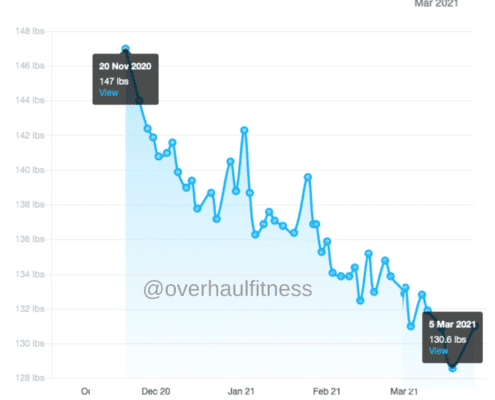Weight Loss Is Sexist: 3 Reasons Why It’s Harder For Women
Feb 17, 2021 by Jackie Lindal and Michael Fouts
Read time: 3 min
You’ve probably heard this story before: a husband and wife both want to lose weight. The wife gives up sugar (whatever that means), carbs, pop, and decides to only drink water. Additionally she aims to exercise 5x per week. After 4 weeks, she’s lost 2 pounds. On the other hand the husband simply cuts back his snacking and alcohol intake, with no big change in exercise habits. In the same time frame he loses 6lbs.
“What the actual f*ck?” frustratingly thinks the wife.
This post will help you understand the reason for this frustration, and why it’s harder for women to lose weight.
Something you need to know: how weight loss occurs is the same for both sexes. For weight loss to occur, male or female, you must be in a caloric deficit. That means you are burning more calories than you are taking in through food, creating a calorie (energy) deficit. Your body needs to make up for that deficit so it uses your stored body fat for extra fuel, thus causing weight loss.
So why is weight loss sexist? Well 3 reasons are:
1. Bigger Energy Demands
One of the biggest reasons why men generally have an easier time losing weight is: they’re bigger (usually). This usually means that they also have more muscle mass. Together, this means that they need more energy to sustain themselves. So when they are going to diet to lose weight, creating something like a 500 calorie deficit a day is easier:
- Male example: 2500 (their maintenance intake) → 2000 (diet deficit intake, 500 calorie deficit) = 20% reduction
- Female example: 2000 (their maintenance intake) → 1500 (diet deficit intake, 500 calorie deficit) = 25% reduction
*the maintenance intakes are just examples, actual values will vary
1lb. of fat is equal to approximately 3500 calories. That total doesn’t change if you’re male or female.
2. Societal Norms
It is fairly normalized for both sexes to eat the same amount of food. For example, if you both go out for dinner at a restaurant you might share an appetizer and both get a main course. It’s also no secret that our food portion sizes are vastly oversized.
So without self-correcting along the way, many women will unknowingly consume a lot more calories than they actually need and this overconsumption will disproportionally affect them more.
Further, societal norms suggest what is socially acceptable for exercise with women. Marketing for exercise routines and equipment for women is vastly different from what is promoted for men. For women, there’s a large emphasis on cardio such as spin, yoga, and using only small, pink, light weights as the narrative. Whereas for men, strength training is more popular. As a result, many women miss out on the benefits of strength training to help them build and maintain muscle while losing fat – also partly to blame are pervasive myths like thinking weight training will make them look big and bulky.
- Related Read: The Best Strategy For Weight Loss Includes Weight Training
- Related Read: Lifting Weights Will Make You Bulky…Just Kidding, It Won’t
3. Hormones
First off, hormones themselves don’t directly affect your ability to lose weight. They do, however, indirectly affect you psychologically – which can have an impact on your ability to lose weight. One of these ways is weight fluctuations. Many women will notice that a week or so before their period starts, they see the scale go up. For those that don’t understand these fluctuations, this can be demotivating and cause frustration. Secondary to weight fluctuations, mood changes (like those seen with PMS) can cause strong food cravings.
The above two points put together, it can be more mentally challenging to restrict caloric intake and harder to diet during mood and motivation swings – like avoiding foods that are more calorically dense that you enjoy.
Not all is lost!
Yes, men have it easier. But, that does not mean that it’s impossible for women to lose weight.
Here are some tips on how to help improve your weight loss success.
1. Don’t solely measure progress with the scale. When you put all emphasis on the scale for your goals, it can be a frustrating endeavour when the scale doesn’t do exactly what you want. As mentioned before, weight fluctuations are much more common for women. Using the scale as one data point is fine, but also tracking your progress in other ways such as progress photos, measurements, strength goals, consistency goals, etc. all help show changes not reflected on the scale.
2. Add weight training to your exercise routine. Weight and strength training has previously been a taboo way to workout for women. That being said, modern society is starting to shift thanks to sports such as Crossfit making weight training more mainstream. From a weight loss and quality of life perspective, the benefits of weight training for women are unequivocal. Adding strength training with a progressive overload 3-5x per week helps to increase muscle mass, which burns more calories at rest and over time, increases your metabolism. This makes weight loss easier and more successful in the long term.
3. Consume adequate amounts of protein. To be able to build and maintain muscle mass, you need to ensure you are eating adequate protein. Ideal amounts are around 0.73 to 0.86 grams/lb bodyweight/day. Serving protein with each meal and snack helps to get the proper amounts of protein per day.
- Related Read: How Much Protein You Need For Different Fitness Goals
4. Emphasize good quality sleep & recovery. Just as weight training and adequate protein are important for weight loss and building muscle mass, so is sleep & recovery. Good quality sleep (7-9 hours per night) and recovery help muscles heal between workouts and reduce the risk of injury.
Sleep is also beneficial for weight loss because it gives you more energy during the day and more “emotional control” over your food decisions on the day.
5. Increase NEAT. NEAT stands for Non-Exercise-Activity-Thermogenesis. This includes any activity you do outside of exercise. This could be daily walking, house cleaning, gardening, or any other way to add extra activity into your lifestyle. Increasing your NEAT throughout the week helps to burn more calories, maintain an active lifestyle and decrease stress.
6. Consistency. Women are more likely to hop from workout program to workout program, and from diet to diet when they don’t see the results they want. Many times when you hop from plan to plan, the lack of consistency leads to a lack of results. When you feel like you’re not getting the results you want, instead of changing the plan, check your consistency with the plan and make an effort to stay on track longer.
Interested In Being A Client?
Click Here and fill out a quick interest form and we’ll be in touch!
Or…Stay In Touch
Join everyone else that we email, no more than once per month, to keep in touch about recent blog posts, new workout programs, meal plans and recipes to try, and more…






